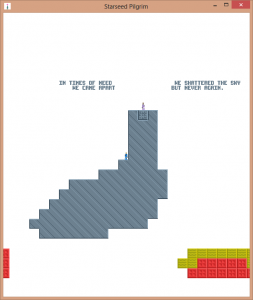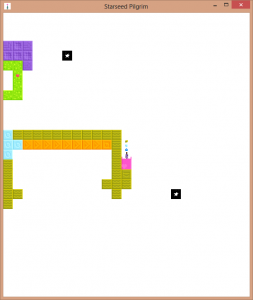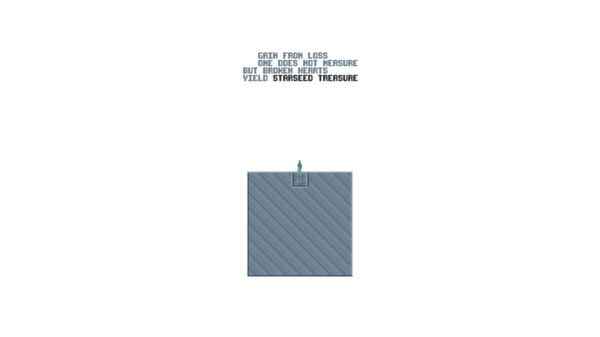 If you can stomach a slightly self indulgent anecdote, then let me tell you about my beginnings as a gamer to help frame this review. If you can’t, then please skip the next paragraph.
If you can stomach a slightly self indulgent anecdote, then let me tell you about my beginnings as a gamer to help frame this review. If you can’t, then please skip the next paragraph.
My first gaming memories are of a treasure trove of games for my Spectrum 48K. It was my first computer, and I bought it second hand along with a big, musty smelling cardboard box filled with Memorex tapes with game names scribbled on their cases. Most of these tapes had many games on them, and because they were all bootleg copies I had no instructions, original packaging or box art. I had a whole world of 8-bit gaming just 8 minutes of (noisy) loading away, but there was a problem. Many of these games were obscure, filled with abstract visuals and vaguely explained gameplay system and were almost impossible to play without instructions. But I struggled on with them, and I discovered many hidden gems. I even had a copy of the brilliant Lords of Chaos, but tragically I never learned how to play it. No matter how long I struggled on, it was impenetrable without any kind of instructions or tutorial system. This was one of the earliest games from the guys who would go on to make XCOM, but I missed out on it. Because learning how to play was too frustrating, difficult and off-putting.
 Fast forward to present day, and I am reviewing a game that delights in obfuscation of its fundamental gameplay. Lauded in the press and by videogames version of Brian Sewell (Jo Blow), Starseed Pilgrim is certainly a game with overt artistic pretensions. Like those old Spectrum games that had no instructions, it’s also confusing, frustrating and obtuse. Although perseverance and immense boredom will eventually give way to understanding and a modicum of enjoyment, the sad truth is that you would have a more rewarding gameplay experience with Lords of Chaos on those old rubber keys.
Fast forward to present day, and I am reviewing a game that delights in obfuscation of its fundamental gameplay. Lauded in the press and by videogames version of Brian Sewell (Jo Blow), Starseed Pilgrim is certainly a game with overt artistic pretensions. Like those old Spectrum games that had no instructions, it’s also confusing, frustrating and obtuse. Although perseverance and immense boredom will eventually give way to understanding and a modicum of enjoyment, the sad truth is that you would have a more rewarding gameplay experience with Lords of Chaos on those old rubber keys.
For some reason the developers and press seem to delight in Starseed Pilgrims intentionally confusing and frustrating lack of guidance. Meanwhile, anyone purchasing the game without knowledge of the “established narrative” (that this is an important and worthy game) will be left looking at a very naked, very confused Emperor.
Its amateur poetry/narrative/tutorial would shame any self-respecting unemployed beatnik cafe poet, but this is what we have in place of any sort of instructions on how to play this (at least initially) complex title. I managed to stomach Braid’s dialogue even as it neared the event horizon of its creators anus because the gameplay was accessible, enjoyable and smart. But while Braid and Starseed Pilgrim both overplay the whimsical, ethereal prose, in Braid’s case it never impacted on the gameplay. In Starseed Pilgrim meanwhile, it’s all you have to go on as you try to figure out how to play the game. It’s like following the instructions for how to set up your router as written by a first year poetry student in love with James Joyce.
 When you start the game you are given no guidance beyond a brief snippet of this amateur poetry. Your little stick man resides in a world of white space, blocks and unexplained gameplay systems. If you choose to look online for help at this point, you’ll find a conspiracy of silence as (almost) everyone writing about the game seems to be complicit in the developers decision to let the players figure the game out by themselves. Even looking for help on their site will offer nothing. In searching, you may come across a mislabeled “guide” to the game, only to be faced with a quote from Mr Blow himself telling you to explore or make mistakes or some such nonsense. Thanks for that.
When you start the game you are given no guidance beyond a brief snippet of this amateur poetry. Your little stick man resides in a world of white space, blocks and unexplained gameplay systems. If you choose to look online for help at this point, you’ll find a conspiracy of silence as (almost) everyone writing about the game seems to be complicit in the developers decision to let the players figure the game out by themselves. Even looking for help on their site will offer nothing. In searching, you may come across a mislabeled “guide” to the game, only to be faced with a quote from Mr Blow himself telling you to explore or make mistakes or some such nonsense. Thanks for that.
If you search further you may come across the odd gameplay video, but on the whole you’ll find writers flexing their English lit degrees as they dance around the game without telling you anything, using phrases like “Starseed Pilgrim Will Challenge Your Videogame Literacy“. This is an overblown way of saying the developers forgot to include a tutorial, then made a virtue out of it.
(I realise at this point that I’m being overly acerbic. There is a good game in here, and I don’t mean to criticize how other people write about it. I just don’t see the games flaws as unique selling points. Some of these articles are really well written. I just think their opinions are wrong.)
 So diving into the game, you find that as the Pilgrim (a stick man) in a blank white world with a few blocks that you stand on, you can place seeds into the ground to grow new blocks. There’s a few different coloured seeds floating over your head, telling you which seeds you will drop next. This is a bit like the display showing you which Tetris block will fall next, and you can’t choose the order the seeds come out. Different coloured seeds will grow in different patterns. As you drop these seeds into the ground you will grow the game world, while falling off these blocks will result in death. All the while you are also trying to escape a creeping black corruption that is slowly eating up the blocks you have put down, and while outrunning this corruption is impossible, you can delay it by constantly laying more seeds and moving away from it.
So diving into the game, you find that as the Pilgrim (a stick man) in a blank white world with a few blocks that you stand on, you can place seeds into the ground to grow new blocks. There’s a few different coloured seeds floating over your head, telling you which seeds you will drop next. This is a bit like the display showing you which Tetris block will fall next, and you can’t choose the order the seeds come out. Different coloured seeds will grow in different patterns. As you drop these seeds into the ground you will grow the game world, while falling off these blocks will result in death. All the while you are also trying to escape a creeping black corruption that is slowly eating up the blocks you have put down, and while outrunning this corruption is impossible, you can delay it by constantly laying more seeds and moving away from it.
When you are eventually caught by the creeping blackness, the game flips to a “negative”, dark version of the game world. The gameplay changes and the way that you laid out blocks will effect how far you will be able to progress in this dark world.
And that’s all I’m supposed to tell you I suppose. What else can I say, when you’re supposed to figure it out by yourself? Already I’ve said more about the games gameplay systems than most writers. Even the small amount of information I’ve conveyed is more than most are willing to reveal.
“Whats unique about a videogame is that they can teach a player how to play WHILE they play”. That’s the main point of this amazing video by Sequlitis. It says everything I want to say on the subject of game tutorials, only much better:
That’s how you teach a player to play your game. Not by obfuscation. Not by leading them down dead ends. Not with vague systems that are illogical. No. With clever design. With structure. Leaving a player to learn gameplay systems with no guidance isn’t empowering. It’s isolating and it distances the player. Its just mean.
Now those people who love this game will tell you that you need to learn the games systems on your own, and that’s where the fun lies. I disagree, but maybe they are right. If you want to do so, then by all means, don’t read this next link. If you want to know how to play Starseed Pilgrim though, I can’t recommended this piece by Owen Grieve highly enough. After I read this I managed to actually enjoy the game. Before that, I hated every moment of it. I did learn much of this myself, but I still retained many misconceptions about how the game worked. Many of these were misconceptions I would probably never lose if I hadn’t gotten some guidance. Like a trapped animal in an operant conditioning chamber in a Skinner experiment, I developed all sorts of behaviors that were useless. In this case though, I didn’t feel like BF Skinner was experimenting on me, I felt like Droquen was laughing at me.
 Once you get a handle on how to actually play the game, Starseed Pilgrim is a clever puzzle game with some problems. It plays in a small window, and while it would be great to see more of the game level (as it plays out in portrait mode), stretching that window won’t give you more of a view of the play space. Instead, the game will only draw the graphics in a small rectangle in the middle of the screen. It’s also very hard to see the colours of the different seeds you will use as they are displayed above your head. This is an essential element of gameplay, and the only solution is to reduce the resolution for your computer. As I said before, the game offers no options, so changing your volume, graphics setting or anything else is not possible.
Once you get a handle on how to actually play the game, Starseed Pilgrim is a clever puzzle game with some problems. It plays in a small window, and while it would be great to see more of the game level (as it plays out in portrait mode), stretching that window won’t give you more of a view of the play space. Instead, the game will only draw the graphics in a small rectangle in the middle of the screen. It’s also very hard to see the colours of the different seeds you will use as they are displayed above your head. This is an essential element of gameplay, and the only solution is to reduce the resolution for your computer. As I said before, the game offers no options, so changing your volume, graphics setting or anything else is not possible.
There’s a number under your feet telling you how many seeds you have, but most of the time you can’t see it because its displayed behind the blocks in the environment. Meanwhile, in the dark world collecting hearts (which are essential) requires pixel perfect movements. You can’t be JUST close enough to them, you need to have your avatar walk completely through them. In the dark mode there is also a power that lets you float around in a bubble. This is also essential, and sometimes missing a collectible while floating in this bubble will render all your actions in the last ten minutes pointless. Despite this, movement in the bubble is sticky and awkward, and making a mistake here is a frequent and frustrating experience.
 I also had a lot of difficulty moving downwards in the negative world. If you fall too fast you beat the scrolling of the screen and die. When this happened to me at first, I thought I was playing the game completely wrong. It turns out that if you fall more slowly then this won’t happen. I don’t know if it was a bug or intentional, but this one “feature” completely stumped me and meant that although I was playing the game correctly, I thought I was doing something wrong. Again, in a game that refuses to give you any guidance it’s easy to get stuck when it also contains little flaws like this that throw you off the scent.
I also had a lot of difficulty moving downwards in the negative world. If you fall too fast you beat the scrolling of the screen and die. When this happened to me at first, I thought I was playing the game completely wrong. It turns out that if you fall more slowly then this won’t happen. I don’t know if it was a bug or intentional, but this one “feature” completely stumped me and meant that although I was playing the game correctly, I thought I was doing something wrong. Again, in a game that refuses to give you any guidance it’s easy to get stuck when it also contains little flaws like this that throw you off the scent.
Still, I found that once I knew how to play Starseed Pilgrim I could play it without the frustration I initially experienced. It has some lovely sound effects of the plink-plonky art-game style that sound a lot like a tone board, with different sounds used for each block type you add. There’s even a low, threatening, rumbling tone that plays as the corruption gets closer that’s scarily unnerving.
And for all my criticism, there must be something interesting about a game that I can write so much about. I think it’s the misapprehension that annoys me most about Starseed Pilgrim; the implication that I should be more interested in the mystery box than its contents. The fundamental gameplay is like a clever spin on Boulder Dash and Solomon’s Quest, and building up your little worlds can be captivating and enjoyable. Once you get it out of the metaphorical, stubborn packaging. To get to that fun though, the developer thinks you should endure hours of painful experimentation and trial and error. It’s like wrestling with one of those clear, moulded wrappers you get on electronic equipment (eg game controllers), cutting your hands with the scissors and the sharp edges of the plastic. The game that follows is not worth all of the conspiratorial secrecy, and the pretentious prose is unwelcome in what is otherwise an engaging puzzle game.
 “Where Is My Heart?” by Bernie Schulenburg or “To The Moon” by Kan Gao are amazing examples of simple, charming, beautifully designed games with similar themes and presentation. They both have something that Starseed Pilrgim lacks: a clear channel of communication with the player that implicitly explains how to play the game. They’re designed to let the player learn the gameplay systems through experimentation, and as a result they feel like they respect the player. Starseed Pilgrim meanwhile just feels cruel. It might offer some fun and enjoyment for those dedicated enough to persevere through its painful learning curve. Despite this eventual reward, it’s attempt to characterize a lack of a tutorial as a design virtue isn’t honest, it’s just lazy. As a result Starseed Pilgrim is a good game, ruined. I’d leave it in the musty brown box.
“Where Is My Heart?” by Bernie Schulenburg or “To The Moon” by Kan Gao are amazing examples of simple, charming, beautifully designed games with similar themes and presentation. They both have something that Starseed Pilrgim lacks: a clear channel of communication with the player that implicitly explains how to play the game. They’re designed to let the player learn the gameplay systems through experimentation, and as a result they feel like they respect the player. Starseed Pilgrim meanwhile just feels cruel. It might offer some fun and enjoyment for those dedicated enough to persevere through its painful learning curve. Despite this eventual reward, it’s attempt to characterize a lack of a tutorial as a design virtue isn’t honest, it’s just lazy. As a result Starseed Pilgrim is a good game, ruined. I’d leave it in the musty brown box.
5 amateur poets looking for work on indie games out of 10
